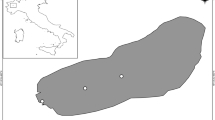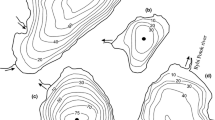Abstract
Mainly from the trends of fish yield four stages of fish succession in European lakes under cultural eutrophication are described. Trends of transparency, phosphorus, weed, benthos, and plankton are included. Supplementary interrelated effects of eutrophication on fish biology (growth, fat content, condition, distribution, reproduction, parasites, fish kills, introgression, feeding) have been collected from literature. The effects, mainly observed on planktivores, are not specific for species or localities.
Similar content being viewed by others
Literaturverzeichnis
Andersson, G., Berggren, H., und Hamrin, S.: Lake Trummen restoration project. Verh. int. Ver. Limnol.19, 1097–1106 (1975).
Anonymus: Weissfisch-Explosion im Ammersee. Fischer Teichwirt26, 73 (1975).
Biró, P.: Lake Balaton: effects of exploitation, introductions and eutrophication on the percid community. PERCIS-Contr. (Quetico, Kanada), TS, S. 34 (1976).
Bonomi, G., Gerletti, M., Indri, E., und Tonolli, L.: Report on Lake Maggiore. In: Eutrophication in large lakes and impoundments. Upsala Symposium Skoloster, Sweden, Mai 1968 (Paris), OCSE, S.299–341 (1970).
Boyd, J.C., und Laurent, P.J.: Perch of Lac Leman (Lake Geneva): Attempts at interaction of four states. MS, S. 13 (1976).
Brutschy, A., und Günthert, A.: Gutachten über den Rückgang des Fischbestandes im Hallwilersee. Arch. Hydrobiol.14, 523–567 (1924).
Buhse, G.: Die Entwicklung des Fischbestandes im Edersee als Folge einer guten Talsperrenbewirtschaftung. Allg. Forst Jagdztg.136, 238–242 (1965).
Buhse, G.: Das Steinhuder Meer in fischereilicher und limnologischer Sicht mit Empfehlungen zu wasserwirtschaftlichen Baumassnahmen. N. Arch. Nds.20, 115–130 (1971).
Caspers, H., und Mann, H.: Bodenfauna und Fischbestand in der Hamburger Alster. Abh. Verh. Naturwiss. Ver. Hamburg (N.F.),5, 89–110 (1960).
Chevalier, J.R., Entz, B.A.G., Hartmann, J., Johnson, M.G., Kelso, J.R.M., Leach, J.H., Nümann, W., und Rundberg, H.: Responses of Percid fishes to eutrophication. MS, S. 27 (für J. Fish. Res. Bd Can. 1977, Special issue).
Colby, P.J., Spangler, G.R., Hurley, D.A., und McCombie, A.M.: Effects of eutrophication on salmonid communities in oligotrophic lakes. J. Fish. Res. Bd Can.29, 975–983 (1972).
Dahms, E.: Limnogeologische Untersuchungen im Dümmer-Becken im Hinblick auf seine Bedeutung als Natur- und Landschaftsschutzgebiet (Schlussbericht). Geol. Unters. Nieders. Binnenseen29, 1–231 (1972).
Deelder, C.L.: A contribution to the knowledge of the stunted growth of perch (Perca fluviatilis L.) in Holland. Hydrobiologia3, 357–378 (1951).
Grimaldi, E., Lago Maggiore: effects of exploitation and introductions on the salmonid community. J. Fish. Res. Bd Can.29, 777–785 (1972).
Grimaldi, E., und Nümann, W.: The future of salmonid communities in the European subalpine Lakes. J. Fish. Res. Bd Can.29, 931–936 (1972).
Grimås, U. Nilsson, N. -A., Wendt, C.: Lake Vättern: Effects of exploitation, eutrophication, and introductions on the salmonid community. J. Fish. Res. Bd Can.29, 807–817 (1972a).
Grimås, U., Nilsson, N. -A., Toivonen, J., und Wendt, C.: The future of salmonid communities in Fennoscandian Lakes. J. Fish. Res. Bd Can.29, 937–940 (1972b).
Haempel, O.: Fischereibiologie der Alpenseen. Binnengewässer10, 1–259 Schweizerbart, Stuttgart 1930.
Hagena, W.: Der Hemmelsdorfer See. Fischereibiologische Untersuchungen eines Strandsees an der deutschen Ostseeküste. Diss. Kiel. S. 151 (1968).
Hamm, A.: Limnologische Untersuchungen am Tegernsee und Schliersee nach der Abwasserfernhaltung (Stand 1970). Wass. Abwass. Forsch., S. 131–150 (1951).
Hartmann, J.: Der Barsch (Perca fluviatilis) im eutrophierten Bodensee. Arch. Hydrobiol.76, 269–286 (1975).
Hartmann, J.: Sukzession der Fischerträge in kulturbedingt eutrophierenden Seen. Fischwirt27, 35–37 (1977).
Hartmann, J.: Die Trüsche (Lota lota) im eutrophierten Bodensee. Arch. Hydrobiol.80, 360–374 (1977).
Hartmann, J., und Löffler, H.: Saisonale bodennahe Verteilung von Fischen im eutrophierten Bodensee. Arch. Hydrobiol., im Druck.
Hartmann, J., und Nümann, W.: The percids of eutrophicated Lake Constance. PERCIS-Contr. (Quetico, Kanada) TS, S. 21 (1976).
Hasler, A.D.: Eutrophication of lakes by domestic drainage. Ecology28, 383–395 (1947).
Hass, G.: Die Eutrophierung der Edertalsperre und ihre Folgen. Fischwirt21, 1–8 (1971).
Heinonen, P., und Falck, P.: The effect of waste water on fish. Aqua Fenn., S. 105–110 (1971).
Heller, F.: Vom Baldeggersee. Schweiz. Fisch. -Ztg.17, 38–39 (1909).
Hinterberger, C.: Die Fischerträge in den Salzkammergutseen. Hausarb. Univ. Wien TS, S. 63 (1974).
Kempe, O.: The growth of the roach (Leuciscus rutilus L.) in some Swedish lakes. Rep. Inst. Freshw. Res. Drottningholm44, 42–104 (1962).
Kölbing, A.: Der Starnberger See und die seinem Trophiezustand angemessene Bewirtschaftungsweise des Coregonenbestandes. Veröff. Zool. Staatssamml. München17, 1–108 (1974).
Krause, A.: Einfluss der Eutrophierung und anderer menschlicher Einwirkungen auf die Makrophytenvegetation der Oberflächengewässer. Ber. Landwirtsch.50, 140–146 (1972).
Larkin, P.A., und Northcote, T.G.: Fish as indices of eutrophication. In: Eutrophication: causes, consequences, correctives. Proceedings of a symposium, S. 256–273. Nat. Acad. Science, Washington, D.C. 1969.
Laurent, P.J.: Les argules du Léman. Schweiz. Z. Hydrol.37, 249–252 (1975).
Leucht, G.: Die fischereiliche Bewirtschaftung der Talsperre Pirk. Dt. Fisch. -Ztg.12, 249–253 (1965).
Liebmann, H.: Die Abhängigkeit der Fischfauna von ökologischen Faktoren in oberbayerischen Seen. Verh. dt. Zool. Ges., S. 518–527 (1963).
Liepolt, R.: Die limnologischen Verhältnisse des Zellersees, seine Verunreinigung und Reinigung. Föd. Europ. Gewässersch. Inf. Bl.14, 59–62 (1967).
Lyagina, T.N.: Connection of egg weight with biological indices of female roach,Rutilus rutilus, with different abundance of food. J. Ichthyol.15, 584–594 (1975).
Minder, L.: Der Zürichsee im Lichte der Seentypenlehre, S. 83 Fretz, Zürich 1943.
Müller, K.: Fischereibiologische Untersuchungen am Edersee. Ber. Limnol. Flußstat. Freudenthal3, 26–35 (1952).
Neumann, H.: Beiträge zur Limnologie des Zwischenahner Meeres—unter besonderer Berücksichtigung der Nährstoffbelastung und der Reinhaltemassnahmen im Einzugsgebiet. Vom Wass.41, 163–186 (1973).
Nümann, W.: Die Veränderungen im Blaufelchenbestand (Coregonus wartmanni) und in der Blaufelchenfischerei als Folge der künstlichen Eutrophierung des Bodensees. Verh. int. Ver. Limnol.15, 514–523 (1964).
Nümann, W.: Versuch einer Begründung für den Wandel in der qualitativen und quantitativen Zusammensetzung des Fischbestandes im Bodensee während der letzten 60 Jahre und eine Bewertung der Besatzmassnahmen. Schweiz. Z. Hydrol.35, 206–238 (1973).
Quartier, A.: La pêche dans les eaux du canton de Neuchâtel. Schweiz. Fisch. -Ztg.75, 76–81 (1967).
Ohle, W.: Nährstoffanreicherung der Gewässer durch Düngemittel und Meliorationen. Münch. Beitr. Abwass. -Fisch. -Flussbiol.12, 54–83 (1965).
Regier, H.A. und Loftus, K.H.: Effects of fisheries exploitation on salmonid communities in oligotrophic lakes. J. Fish. Res. Bd Can.29, 959–968 (1972).
Roth, H.: Das Weissfischproblem in der Schweiz. Veröff. Eidg. Amt Gewässersch. Eidg. Fischerei-insp.26, 1–69 (1970).
Roth, H., und Geiger, W.: Brienzersee, Thunersee and Bielersee: effects of exploitation and eutrophication on the salmonid communities. J. Fish. Res. Bd Can.29, 755–764 (1972).
Ruhlé, C.: Die Bewirtschaftung des Seesaiblings (Salvelinus alpinus salvelinus L.) im Zugersee. Diss. ETH Zürich 5809, S.221 (1976).
Rufli, H.: Biologie der Coregonen im Thuner- und Bielersee. Diss. ETH Zürich, S. 178 (1975).
Rundberg, H.: Sander, perch and pike in lakes Mälaren and Hjälmaren, Sweden. PERCIS-Contr. (Quetico, Kanada) TS, S. 31 (1976).
Sachs, L.: Statistische Auswertungsmethoden, S. 667, Springer, Berlin, Heidelberg, New York 1969.
Schmid, J.: Über die Fischerei im Schliersee. Allg. Fisch. -Ztg.91, 409–410 (1966).
Schmid, J.: Abschied von der kleinen Maräne. Allg. Fisch. -Ztg.100, 640–641 (1975).
Schmidt, E.: Ökosystem See, S. 170, Quelle und Meyer, Heidelberg 1974.
Scott, W.B., und Crossman, E.J.: Freshwater fishes of Canada. Fish. Res. Bd Can. Bull. 184, 1–966 (1973).
Stangenberg, M.: Fortschreiten der Eutrophierung der Seen in Polen und die sich daraus ergebenden Konsequenzen. Dt. Fisch. -Ztg.13, 290–299 (1966).
Stammer, A. -H., und v. Ammon, F.: Die Verunreinigung des Kochelsees—chemisch-biologische Untersuchungen zur Aufstellung eines Gütebildes. Münch. Beitr. Abwass. -Fisch. -Flussbiol.4, 105–115 (1958).
Steinmann, P.: Die Gewässersanierung als dringlichstes Arbeitsbeschaffungsprojekt. Schweiz. Fisch. -Ztg.41, 294–302 (1941).
Stöcklhuber, K.: Zur Entwicklung der Fischerei im Tegernsee bis 1974. Fischwirt27, 1–4 (1977).
Svärdson, G. Interspecific population dominance in fish communities of Scandinavian lakes. Rep. Inst. Freshw. Res. Drottningholm55, 144–171 (1976).
Tesch, F.W.: Wie Zander und Blei den Barschbestand verdrängen. Allg. Fisch. -Ztg.90, 726–728 (1965).
Thomas, E.A.: Experimentelle Untersuchungen über die Schlammbildung in unberührten und kulturbeeinflussten Seen der Schweiz. Wass. Abwass., S. 154–169 (1963).
Thomas, E.A.: Oligotrophierung des Zürichsees. Vjschr. naturf. Ges. Zürich116, 165–179 (1971).
Thomas, E.A.: Fischsterben in Seeabflüssen durch Hyperphotosynthese. Verh. int. Ver. Limnol.18, 454–460 (1972).
Vivier, P.: L’évolution depuis le début du siècle du peuplement piscicole du Léman français. Schweiz. Z. Hydrol.37, 195–199 (1974).
Wille, W.: Dembke, K., und Poltz, J.: Limnologische Untersuchung des Steinhuder Meeres 1964–1971. Mitt. Nds. Wasseruntersuchungsamt Hildesheim1, 1–64 (1976).
Willer, A.: Die Seentypenfrage und die praktische Fischerei. Fisch. -Ztg.28, 149–155 (1925).
Author information
Authors and Affiliations
Rights and permissions
About this article
Cite this article
Hartmann, J. Fischereiliche Veränderungen in kulturbedingt eutrophierenden Seen. Schweiz. Z. Hydrologie 39, 243–254 (1977). https://doi.org/10.1007/BF02502671
Received:
Issue Date:
DOI: https://doi.org/10.1007/BF02502671




